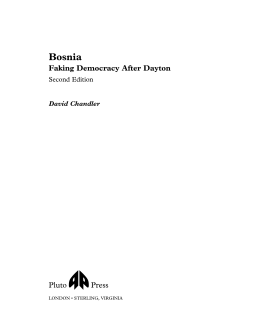
Additional Information
Book Details
Abstract
The Dayton Accords brought the Bosnian war to an end in November 1995, establishing a detailed framework for the reconstitution of the Bosnian state and its consolidation through a process of democratisation.
In Bosnia David Chandler makes the first in-depth critical analysis of the policies and impact of post-Dayton democratisation. Drawing on interviews with key officials within the OSCE in Bosnia and extensive original research exploring the impact of policies designed to further political pluralism, develop multi-ethnic administrations, protect human rights and support civil society,
Chandler reveals that the process has done virtually nothing to develop democracy in this troubled country. Political autonomy and accountability are now further away than at any time since the outbreak of the Bosnian war.
'A devastating analysis'
Simon Jenkins, The Times
Table of Contents
| Section Title | Page | Action | Price |
|---|---|---|---|
| Contents | v | ||
| List of Tables | vii | ||
| List of Abbreviations | viii | ||
| Acknowledgements | x | ||
| Introduction | 1 | ||
| 1. Democratisation | 7 | ||
| FROM DEMOCRACY TO DEMOCRATISATION | 7 | ||
| DEMOCRATISATION AND SOVEREIGNTY | 17 | ||
| CONCLUSION:DEMOCRATISATION AND THE BOSNIAN WAR | 27 | ||
| 2. Dayton and Sovereignty | 34 | ||
| DAYTON IN CONTEXT | 38 | ||
| THE DAYTON PROCESS AND BOSNIAN SOVEREIGNTY | 55 | ||
| CONCLUSION | 64 | ||
| 3. Power-sharing and multi-ethnic administrations | 66 | ||
| STATE LEVEL | 69 | ||
| ENTITY LEVEL | 72 | ||
| THE KEY CITIES:MOSTAR, SARAJEVO AND BRCKO | 78 | ||
| MUNICIPAL AUTHORITIES | 87 | ||
| CONCLUSION | 88 | ||
| 4. The protection of human rights | 90 | ||
| INTERNATIONAL TREATIES | 91 | ||
| THE CONTINUUM OF HUMAN RIGHTS ABUSE | 95 | ||
| RESTORING A CLIMATE OF CONFIDENCE? | 99 | ||
| CONCLUSION | 109 | ||
| 5. Political pluralism | 111 | ||
| THE REGULATORY FRAMEWORK | 114 | ||
| CREATING A POLITICALLY NEUTRAL ENVIRONMENT? | 119 | ||
| THE SUCCESS OF INTERNATIONAL REGULATION IN\r CHALLENGING NATIONAL PARTIES | 127 | ||
| CONCLUSION | 132 | ||
| 6. Building civil society | 135 | ||
| BUILDING CIVIL SOCIETY | 137 | ||
| CIVIL SOCIETY BEFORE DEMOCRACY? | 144 | ||
| CIVIL SOCIETY AND DEMOCRACY IN BOSNIA | 149 | ||
| CONCLUSION | 152 | ||
| 7. Assessments | 154 | ||
| MORE DEMOCRATISATION BUT LESS DEMOCRACY | 155 | ||
| OFFICIAL ASSESSMENTS | 159 | ||
| THE LIBERAL ASSESSMENT | 164 | ||
| THE CONSERVATIVE ASSESSMENT | 169 | ||
| THE CONTRADICTIONS OF THE EXTENDED DEMOCRATISATION MANDATES | 173 | ||
| CONCLUSION | 179 | ||
| 8. The external dynamic of democratisation | 181 | ||
| DEMOCRATISATION AND THE INTERNATIONAL ORDER | 181 | ||
| THE EXTERNAL DRIVE TO DEMOCRATISE | 187 | ||
| CONCLUSION | 191 | ||
| 9. Conclusion | 193 | ||
| Afterword: From Dayton to Rambouillet | 200 | ||
| THE BOSNIAN FARCE | 201 | ||
| THE KOSOVAN TRAGEDY | 204 | ||
| RESPECTING YUGOSLAV SOVEREIGNTY? | 206 | ||
| KOSOVAN AUTONOMY? | 207 | ||
| CONCLUSION | 211 | ||
| Notes | 212 | ||
| Chapter 3 | 212 | ||
| Chapter 4 | 212 | ||
| Chapter 5 | 213 | ||
| Chapter 6 | 214 | ||
| Chapter 7 | 215 | ||
| Chapter 8 | 215 | ||
| References and Select Bibliography | 216 | ||
| Index | 245 | ||
| Abdic, Fikret 42 | 42 | ||
| Africa 190 | 190 | ||
| Ahlund, Christian 161 | 161 | ||
| Albania | 185 |
